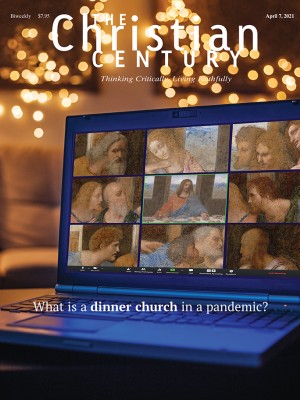10 ways for Christians to embrace our creative power
Being born is a holy calling to join God in free, joyful, and playful expression.

“In the beginning God created the heavens and the earth” (Gen. 1:1). The very first picture of God we see catches God in the act of creating. What if the continual expansion of the universe and our willing and resistant evolving in it are proof that God did not stop creating after Genesis 1 and 2? What if God was just getting started? What if God is always just getting started?
With all due respect for prayer and study, the best way to get a real feel for God’s essence is to watch a child at deep play. Such freedom! Such joy! Creativity is what happens when freedom and joy come together. It is the overflow of freedom and joy. When Jesus says, “Whoever does not receive the kingdom of God as a little child will never enter it” (Mark 10:15), he is signaling and suggesting that somehow God, childlikeness, and the domain of free, joyous expression go together—that such realities share a certain commonality that makes life happen in its freshest, finest, and fullest way, over and over again.
Read our latest issue or browse back issues.
Being born as children is a holy calling to join God in free, joyful, and playful creative expression. It is easy to forget this calling in the throes of a vast assortment of dehumanizing and diminishing realities that seek to snuff the Spirit right out of us from the day we are born. That is why we must, in the words of Jesus, be “born again” (John 3:3). To be born again is not, first and foremost, to have our souls saved for residence in heaven in the next life but to have our souls reclaimed for dynamic creative experience and expression with God and one another in this life.
We are all expressions of a Spirit of creativity in whom freedom and joy have their playful way. Creativity is not just what God does. Creativity is who God is. Therefore, the power to create is in us all. Creative inspiration is a divine, ever- flowing, overflowing stream. Each of us is not just a precious creation of God; we are powerful creators with God. We have holy authorization to use our sacred power to create in every area of our lives: sculpting new ideas, framing new attitudes, and building new relationships.
Seeing God in a more creative light invites us to hear and move freely to the creative rhythms of the gospel. The closer people got to Jesus, the more imaginative and daring they seemed to become. Peter did not try walking on water until he saw Jesus doing it. Martha had not wondered about her brother coming back from the dead until she heard what Jesus had in mind. The whole lot of them could not have imagined that Calvary wasn’t the end of it all until it wasn’t. There was no following Jesus without taking in and taking on the wild and wonderful possibilities he inspired day in and day out.
There is no way to fully follow Jesus today without having our curiosity and imagination baptized in the waters of his lavishly creative spirit. We die not only with the absence of breath but also with the absence of curiosity and imagination. The good news is that being in Christ makes us not only new creations but also new creators. Spiritual transformation involves embracing our divine creative power and wielding it in the spirit of limitless love, freedom, and joy from which we receive it. Here are ten ways to begin.
1. Expect to be creative. Creativity is much broader than making art. It is the means by which we live our lives. Every decision, action, or reflection is an expression of our creative spirit. The question is this: How and what will you choose to deliberately create? An essential practice of believing in God as creative Spirit is to expect without hesitancy or shame God’s continual refreshing of our own creativity. Befriend your creative spirit and learn to be at home with the astonishing.
2. Connect with your inner child. We tend to be far more imaginative and creative as children than we are as adults. Fortunately, the child in us is never vanquished altogether. Allow your abiding child to call forth your creative powers. Daydream, doodle, wonder, and wander. Keep a picture of yourself as a child nearby to help you tap into the springs of limitless imagining inside.
3. Be energized by your inspirations. What energizes you and fills you with an insurmountable feeling of being thoroughly alive? Anything that does so should be brought to bear on your creativity. Freely draw from what inspires you to energize your mind, body, and soul for all-out making. Hold nothing back.
4. Practice patient attention. We miss so much when we stop noticing. Living at a sacred pace—one that allows for noticing more than usual and for relishing details—give us more to enjoy and use in our creative play. Creative inspirations are everywhere, including the smallest of things and the slightest of moments. Paying attention just a half second longer may yield an insight or inspiration more than worth the extended look. Slow down and see what shows up, being especially alert to the surprising and interesting. Watch for zones of intense creative flow. Notice when you are in such a zone, and dance with the Spirit.
5. Find freedom in lavish openness and radical receptivity. Freedom is at the heart of God, and thereby at the heart of the divine reality of creative expression. But how does one live freely? I feel most free when I give up fixations on my own preferences and open myself to ideas that do more than just confirm what I already know. I feel a certain sanctified detachment that grants me permission to seek and be fulfilled by purely new experiences. Energies that might be given to holding on are allocated to letting go, and I find myself engaged and inspired in genuinely different ways. In such a state, fresh creativity is inevitable.
6. Feed anticipation and cultivate excitement. Zora Neale Hurston gives a momentous testimony to the power of triumphant joy: “I have been in Sorrow’s kitchen and licked out all the pots. Then I have stood on the peaky mountain wrapped in rainbows, with a harp and a sword in my hands.” Anticipation is an unsung elixir for living with deliberate joy. One way I intentionally feed anticipation and cultivate excitement, or “FACE,” is to keep a FACE joy journal. When I wake up, I simply think about what I am most looking forward to that day. Merely writing these ideas down builds anticipation and intention for them, stirring up enthusiasm that may not otherwise exist. The more energy you have and feel, the greater your desire and capacity to create.
7. Keep a creativity journal. Another way of taking your creative power into your own hands is to saturate your mind and spirit with energizing thoughts. Several years ago, I began coaching myself daily with written affirmations and reflections that kept my creative juices flowing. Before I knew it, I had dozens of inspirations I could turn to at any time. Consider maintaining your own creativity journal. It may consist of both your own words and quotes from others. Doodles, pictures, and other images are also wonderful ways to intentionally and regularly evoke your creative spirit.
8. Practice emptying. I have a beautiful, handcrafted piece of pottery on my desk. This small bowl, a gift from a pastor with creative hands, is one of my most precious possessions. It remains empty, and I use its emptiness to help me reach my own feeling of emptiness several times each day. In these moments, I practice putting my own preferences and prejudices aside, trying to be open and receptive to God on God’s terms rather than mine. This emptiness refreshes me in ways I cannot fully explain. Surrendering all has a way of yielding all beyond our wildest imagination. The worst grip of all is holding on too tightly to what you already know.
9. Rest your mind. One of the best things you can do for any creative undertaking is to temporarily take your mind off it.
I call my mental respites “peace pockets.” These 20-minute periods are tender times of what Mary Oliver calls “not-thinking, not-remembering, and not-wanting.” Sometimes I just look out the window. I may play music or light a candle. I may be walking or seated. The essential element is that my mind is resting. The result is renewed energy and focus. Sometimes I’m also given an idea or connection that was patiently waiting for me to have the space to hold it.
10. Sleep, nap, rest your body. Physical rest is a must for sustaining creative strength. A rested body leads to peace. Peace leads to clarity. Clarity leads to creativity. When Jesus wields his creative power against the waves that are swamping the boat (Mark 4:35–39), calming the storm with mere words, he has just awoken from a nap. This detail isn’t incidental to the story; it’s crucial.
Unleashing our creative potential isn’t always easy. When Dizzy Gillespie came onto the musical scene in the early 1940s with a new rhythmic style of jazz called bebop, he was denounced by many critics and fellow musicians. One of the criticisms was that bebop was not as easy to dance to as the big band swing that was then popular. Similarly, some of our most important creative callings will be seen as more challenging than charming, more threat than treat. Sometimes our offerings to the world will yield long stretches of waiting as we search in vain for eyes, ears, and hearts ready to listen and applaud.
Gillespie and others persisted. Eventually appreciative ears formed and called forth the flourishing of a new musical expression. (By the way, it’s not that hard to dance to bebop. You just have to be open to dancing in a different way.)
That we are called by God to create in life and ministry is no small thing. It is magnificent and mighty beyond all words and wounds. Creativity—divine and human—is truly something to be celebrated. Although the process of creating may not always feel like a party, God’s creative Spirit is never far from us.
A version of this article appears in the print edition under the title “Holy creativity.” This article is adapted from a new chapter in the 20th anniversary edition of Jones’s Rest in the Storm: Self-Care Strategies for Clergy and Other Caregivers, © 2021 by Judson Press. Used by permission of Judson Press.






